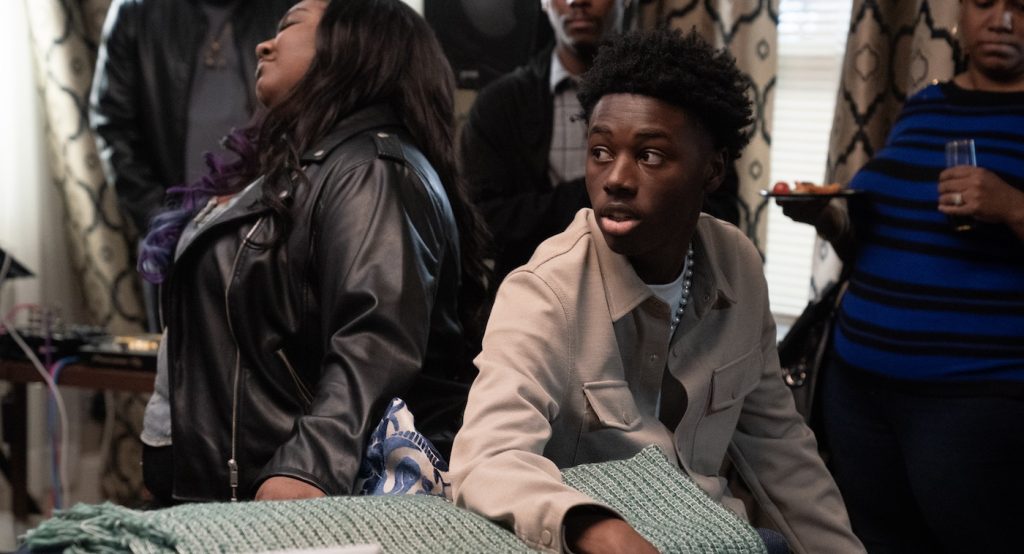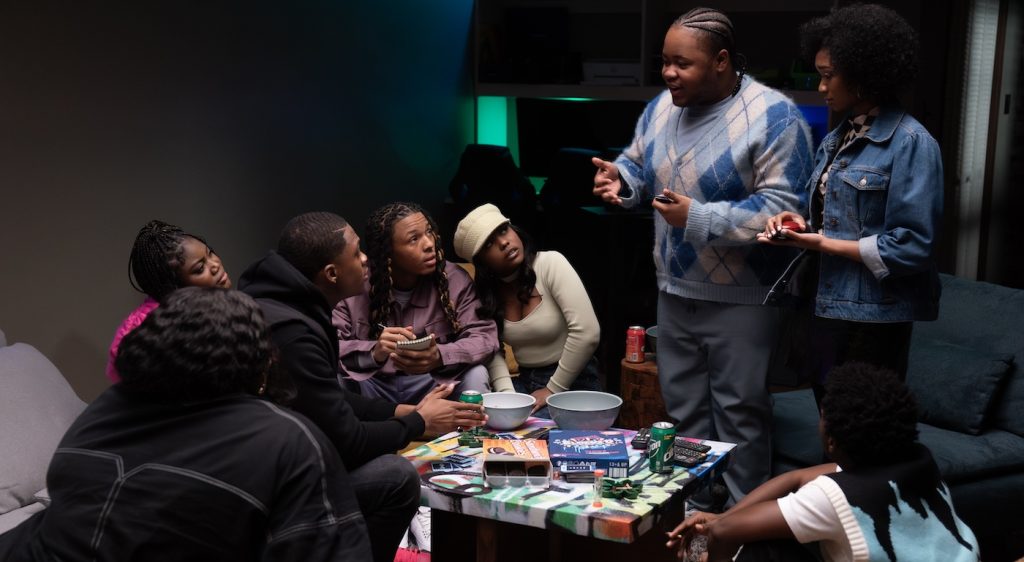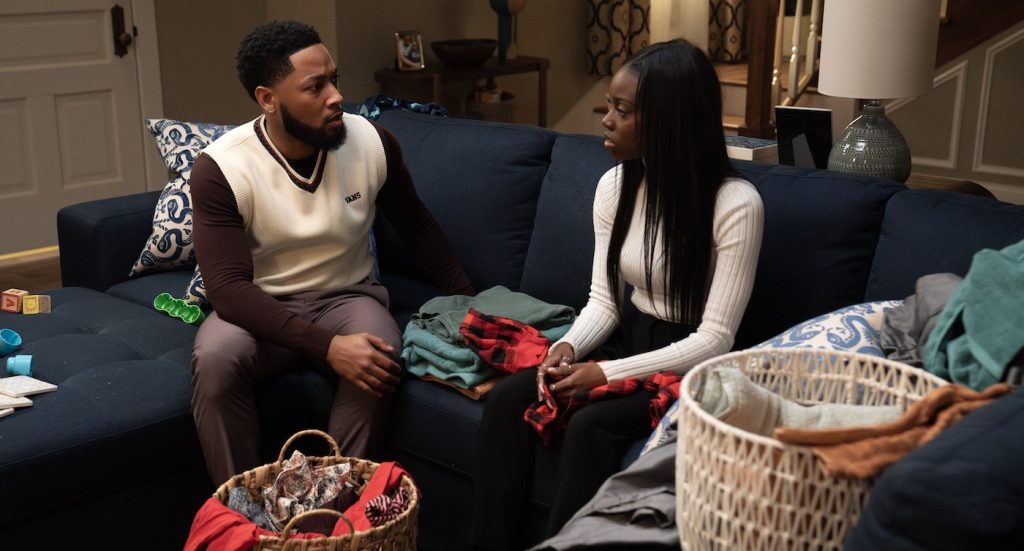“The Chi” Producer/Directors Deondray Gossfield and Quincy LeNear Gossfield on Shaping Lena Waithe’s Sharp Showtime Series
The Chi directors/producers Deondray Gossfield and Quincy LeNear Gossfield are living proof of the collaborative spirit. They live and work together (they’re married), and when they directed episode 4 in season 5, “On Me,” in Lena Waithe’s coming-of-age Showtime series, the talented creator recognized she’d found two collaborators who could take on a larger role for season 6. That meant both directing and producing.
“We were already fans of the show before we started working on it, so we didn’t need much hand-holding as far as the characters were concerned,” Deondray says. “It was so exciting to be let in on the story arcs as they were being fleshed out in real-time.”
The Chi is, naturally, set in Chicago, following residents of the South Side and their interconnected, often extremely challenging lives. Waithe’s series is often compared to David Simon’s era-defining HBO series The Wire, which offered a pointillist snapshot of life in Baltimore, although The Chi is often a more tender portrayal, if no less clear-eyed about the challenges its characters face. The series is led by a deeply talented ensemble cast, including Lynn Whitfield, Jacob Lattimore, Luke James, Jason Weaver, and Jill Marie Jones.
We spoke to the Gossfields about their working relationship, their philosophy for creating great TV, and how their duties, and skills, naturally blur and flow.
Photo Credit: Elizabeth Sisson/Paramount+ with SHOWTIME
What was your research process like coming into The Chi in season 5, with such a rich cast of characters and so many established storylines to carry forward?
Deondray: We were already fans of the show, so we already knew the history of all the characters and where they might be going; however, we did rewatch the entire series to remind ourselves of the evolution of the show. Visually, The Chi has had several aesthetics that were specific to each season, but there were always some signature looks and a directorial style that permeated throughout. We wanted to know what our creative boundaries were, what might be too much or too off the mark, and how performances varied and crescendoed from season to season. We were trying to see what tools were already in our toolbox and which ones we could add while preserving the integrity and energy of the show.
Quincy: We created a spreadsheet for each of the main and supporting characters and tracked their story arcs and relationships with photos. We also created a document with bullet points and synopsis per episode for all four seasons before we met with our showrunners and our former producing director. We may have over-prepared, if there’s such a thing. We really wanted to be able to speak confidently about the series. We were pretty much plugged into the world of The Chi pretty deeply in season five, so coming into season six as producers, we were ready. We did our homework.
How would you describe the way you handled episode four of season 5, “On Me,” which included a lot of major plot points and shifts?
Deondray: We used the same methods we used when breaking down scenes and applied them to the entire episode. Every scene is a short story with a beginning, middle, and end. Every character within a scene has a transition in tone with a mini story arc. We separated all the storylines within the script as if they were individual short films and broke down where each character started within those storylines and where they ended up. We directed each storyline as if they were standalone, which helped us keep track of them even as they existed within a whole episode. In addition, we found ways to thematically tie them all together to give the episode a story arc as a whole. When you break something down this deeply, you know it like the back of your hand and can maneuver and pivot with ease.
Quincy: We also like to focus on what’s not being said. What people don’t say is actually what motivates their behavior. People rarely say what they really mean. When we are breaking down the script, we are also looking at the emotional and psychological underpinnings of the story. We even write between the lines what’s not being said, and that really helps us tune into the heart of the script. We love pretty, cool, and slick visuals and things that push the art form, but not every moment requires all that jazz. Yet, every moment requires you to capture the story’s core. The story has to remain the ultimate goal, and then we look for ways to visually represent the story creatively.
How did you approach season six? Were there specific aesthetic changes you thought were necessary as the storylines evolved?
Deondray: There were lots of conversations around pivotal plot points for the season, but mostly, it was about elevating the show in general. Lena really liked what we did with our episode on season five and wanted us to apply those same aesthetics and sensibilities to season six. We took all that information and began to work out what the look and tone would be for the season with our DP, Nathan Salter. All the camera work and directing were so deliberate to create intentional visual and performance arcs for the season based on all the early conversations we had with Lena and the Showrunners in pre-production.
Quincy: What I remember most was, “Don’t screw this up!” Lena was putting a lot of trust in us to take on this position. We directed one of the most talked about and loved episodes of season five, and Lena strongly felt that we had captured the essence of what she wanted for The Chi moving forward. It didn’t hurt that we also left a great impression on the cast and crew. It’s not often that a director(s) directs one episode and comes back the following season as the producing director. It’s a big ask, and Showtime wanted to make sure we could tackle it and were the right fit.

What’s your co-directing style like? Do you each tackle different parts of the production, complementing each other’s skill sets?
Deondray: Quincy and I are equally yoked when it comes to skillsets, so we have a very intensive prep process where we audition all of our ideas for each other. We each break down the script separately, mark it up, and then come together to discuss it. About 98% of our individual ideas overlap and require no further discussion. The remaining 2% get auditioned. It can end up being a very obvious win over the two different approaches to a scene, or it can be hours of refining and making strong cases for each idea, sometimes even getting them storyboarded or shooting a mock sequence on our iPhones. The better idea usually wins out in the end, or they’re equally as good, so we pick the easiest one to execute. By the time we arrive to set, we are on the exact same page, so our team and cast are never confused about what we want. We take turns giving directions on set. It really just depends on who has the most energy that day. One of us may be really high energy that morning and start to fade by lunch, so the other will take the lead until we wrap. It’s a tag team.
Quincy: Folks like to say we play good cop/bad cop, or they call us mom and dad on set. I think those roles are interchangeable, but we naturally just flow together like Yin and Yang. We were both professional actors in our early careers, so we understand the language of actors. We also both have degrees in psychology, and understanding people is important, whether it be the desires, needs, and wants of our cast or the motivation of the characters they are playing. Being a student of human behavior really comes in handy as a director. Another thing that we love to do is to audition our ideas visually. I am a visual artist and photographer, and we both have experience as cinematographers. Deondray has edited most of our indie projects, so we use a combination of storyboards, photos, and video to work out some ideas that may seem difficult. We’ll pull out our iPhones, stage a scene, shoot it, and edit together. When we finally talk with our DP, we can communicate our ideas more effectively because they can see what our goal is.

What’s your process like for working with actors? Do you have rules of thumb you return to time and again, or is it different with every performer?
Deondray: Working with actors is our favorite part. Quincy and I started as actors, so we speak their language. There are some things that are universal: be collaborative, listen, leave room for imagination, and be open, but I would say most of what it takes to be an effective director is being able to hone in on each actor’s specific needs. Some need short-hand notes that allow them to fill in the gaps. Some need to have their motivations broken down so that they can understand them from a personal place. Others need constant, real-time feedback, while some prefer to marinate with the script, make choices, and then confer with you about their choices to see if they are on the mark. I think the best work happens when there is a mutual fluidity between the actors and the director. Each of you may have done the homework and painstakingly come up with motivations and emotional arcs that may not work once you get on set and have to adjust to your surroundings or the way another actor in the scene interprets a line. When a new, incredible layer is discovered in those moments, it’s your job as the director to cultivate and enhance it, and the actor’s job to let this affect them and respond to it.
QUINCY: One of the biggest things you can do as a director is to gain your actor’s trust, not by manipulation, but by really caring about them as people and performers by being empathetic. Being an actor can make one feel very vulnerable. Actors have to tap into many sensitive emotions, anger, sadness, fear, etc. and are often physiologically reproducing those states for the camera. Not to mention, there are physically intimate and sexual situations that may also be required. You cannot treat people like puppets or cattle who are only there to do as told. We want our actors to feel protected and in good hands. They know that we have their backs and share a common goal to make them their best, but never at the expense of their humanity. Not everyone works that way, but maybe things need to change.

The Chi season 6 returns to Showtime in 2024. You can watch the first eight episodes of the series on Paramount+.
For more recent interviews, check out these stories:
“The Color Purple” Costume Designer Francine Jamison-Tanchuck’s Stunning Creations
“American Fiction” Writer/Director Cord Jefferson on Cutting to the Heart of the Matter
“Wonka” Production Designer Nathan Crowley on Creating a Chocolatier’s Whimsical World
Featured image: Deondray Gossfield and Quincy LeNear Gossfield. Photo Credit: Elizabeth Sisson/Paramount+ with SHOWTIME



